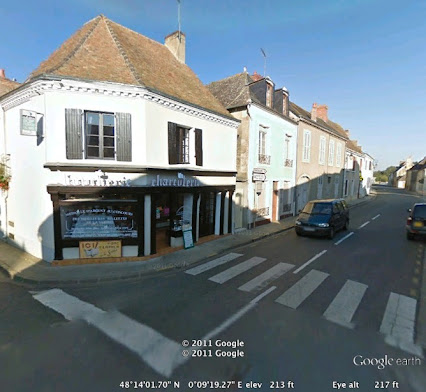I buy, sell, and collect antique postcards as a hobby, and I particularly like cards with interesting messages on the back. Most of the messages run along the lines of "I'm fine. How are you?," "I hope Grandma is feeling better," or "Wish you were here," but occasionally you find something more interesting than that. This blog post is about a card that came out of a dealer's twenty-five-cent sale box at a postcard show and about the card's surprising message.
Postcards in sale boxes are usually common or damaged, but there are always customers for them. Beginning collectors often start their collections from the sale boxes, and artists buy them for collage work or ideas. More advanced collectors and dealers also go through the sale boxes, looking for a "gemstone" in the "gravel." They might find a card that the seller didn't recognize as valuable or a damaged copy of a card that will suffice until a better one turns up. Often the find is just a postcard that appeals to the eye or reminds one of another time or place.
When shopping for postcards at a sale, I go through sale boxes at a fast pace. There are often hundreds of cards in each box, and I count on a very quick look to tell me when to pause. The card pictured below appealed to me on two levels: first, it was an early Japanese postcard with an attractive, hand-tinted rural scene; and second, I knew that many early Japanese cards have significant value. This card’s printed back has no dividing line between an address space and a message space, meaning it was printed before 1907. The edges of the card had a little wear, and it had been written on and postmarked in 1948. These changes were acceptable, but unfortunately, it had a small discolored and rough area on the back where some of the surface of the paper was missing––perhaps where a sticker or a piece of tape had been removed. Collectors of this type of foreign postcard want cards in excellent condition, but at twenty-five-cents, this card seemed to be bargain.
The message on this was neatly written in ink and while the card was mailed in 1948, my guess is that the card was produced about 1905. Glancing at the message, I saw that the name "Lincoln" appeared several times. That got my attention, of course, and here's the payoff:
Message:
8-4-48. The card you mailed in the Mailomat at Chicago shows a Lincoln statue in Lincoln Park.Any Lincoln card is always of interest in this household, especially to Mrs. Matthews. Her father used to sleep with Abraham Lincoln. Her grandfather, Joshua Wagenseller, and Mr. Lincoln were long time friends, beginning when Mr. Lincoln practiced law in Springfield and Pekin, Illinois. Whenever Mr. Lincoln came to Pekin for a term of court, he was always entertained at the Wagenseller home as long as he stayed in Pekin.Mrs. Matthews spent the first twenty-two years of her life in that big Wagenseller home so full of Abraham Lincoln reminders. Thanks for the fine cards.Sincerely, Will C. Matthews, 2310 Fort St., Omaha, Nebr
Lincoln also had strong ties to Pekin, Illinois, and in 1862 he gathered a group of men there to establish the first council of the Union League of America to promote patriotism and loyalty to the Union during the Civil War.
So, the postcard message seems to be legitimate and it tells a Lincoln story that may not be recorded anywhere else. But of course it gets better doesn't it? The message says that Mrs. Matthews' father "used to sleep with Abraham Lincoln."
In recent years there has been some speculation that Lincoln might have been bisexual, based in part on the fact that, as a young lawyer in Springfield, Illinois, he shared a bed for four years with Joshua Speed, a local businessman. This postcard gives us another instance of Mr. Lincoln possibly sharing a bed, or perhaps just a bedroom, with a male––Mrs. Matthews' father, the son of Joshua Wagenseller.
It's an interesting bit of history and open to speculation I suppose, but in the 19th century it was quite common for people of the same sex to share a bed. In many instances, bed space was scarce or expensive, and a comfortable sleeping space was not to be wasted. In fact, when necessary, unmarried house guests of the opposite sex sometimes shared a bed. In such cases a wooden plank called a "bundling board" was often set between them to ensure no "accidental" touching occurred during the night.
In my opinion, these reported sleeping arrangements for Mr. Lincoln are only evidence that even the great Abraham Lincoln needed a good night's sleep like other mortals. Rest in peace, President Lincoln.
So, that's the 25¢ Lincoln story. If you look closely, you can see the price written lightly in pencil on the back of the card. I'd say it was a bargain and a good example of the small treasures that are out there if you keep your eyes open.
BTW, see the Spielberg movie, "Lincoln" as soon as you can. Daniel Day-Lewis is as close as you will ever get to the real Lincoln. Tommy Lee Jones and Sally Field are both terrific, and James Spader almost steals the show. One must keep in mind, however, that the true story is always much more complex than a movie version.
To see a broader view of people who influenced Lincoln, like Frederick Douglass, William Lloyd Garrison, and Harriet Beecher Stowe, you might want to check out the PBS documentary, "The Abolitionists." Here's a link to a review of it written by Mary McNamara of the LA Times:
http://www.latimes.com/entertainment/tv/showtracker/la-et-st-abolitionists-20130108,0,1215367.story








































